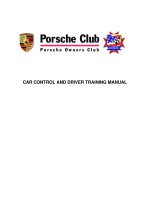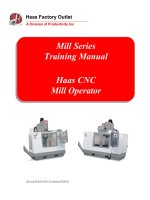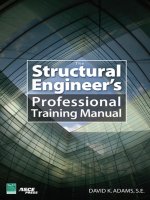The structural engineers professional training manual
Bạn đang xem bản rút gọn của tài liệu. Xem và tải ngay bản đầy đủ của tài liệu tại đây (7.07 MB, 429 trang )
The Structural
Engineer’s
Professional
Training
Manual
ABOUT THE AUTHOR
David K. Adams, S.E., is a registered civil and structural engineer in California
who graduated from the University of California at San Diego with a degree in
Structural Engineering and has practiced with Lane Engineers, Inc. since 1990.
A typical workday for Mr. Adams includes completion of structural calculations,
drawings, and reports on buildings and other structures for commercial, residential, educational, institutional, and industrial uses. In addition to providing planchecking services for local municipalities to determine building compliance with
life safety, accessibility, and structural requirements of current codes, the author
also provides expert review services for California’s engineer licensing board, has
participated in the development of national and California-specific structural
engineering licensing examinations, and is currently an instructor for the
American Society of Civil Engineers.
Copyright © 2008 by The McGraw-Hill Companies, Inc. Click here for terms of use.
The Structural
Engineer’s
Professional
Training
Manual
David K. Adams, S.E.
New York Chicago San Francisco Lisbon London Madrid Mexico City
Milan New Delhi San Juan Seoul Singapore Sydney Toronto
Copyright © 2008 by The McGraw-Hill Companies, Inc. All rights reserved. Manufactured in the
United States of America. Except as permitted under the United States Copyright Act of 1976, no part
of this publication may be reproduced or distributed in any form or by any means, or stored in a
database or retrieval system, without the prior written permission of the publisher.
0-07-159399-3
The material in this eBook also appears in the print version of this title: 0-07-148107-9.
All trademarks are trademarks of their respective owners. Rather than put a trademark symbol after
every occurrence of a trademarked name, we use names in an editorial fashion only, and to the
benefit of the trademark owner, with no intention of infringement of the trademark. Where such
designations appear in this book, they have been printed with initial caps.
McGraw-Hill eBooks are available at special quantity discounts to use as premiums and sales
promotions, or for use in corporate training programs. For more information, please contact George
Hoare, Special Sales, at or (212) 904-4069.
TERMS OF USE
This is a copyrighted work and The McGraw-Hill Companies, Inc. (“McGraw-Hill”) and its licensors
reserve all rights in and to the work. Use of this work is subject to these terms. Except as permitted
under the Copyright Act of 1976 and the right to store and retrieve one copy of the work, you may not
decompile, disassemble, reverse engineer, reproduce, modify, create derivative works based upon,
transmit, distribute, disseminate, sell, publish or sublicense the work or any part of it without
McGraw-Hill’s prior consent. You may use the work for your own noncommercial and personal use;
any other use of the work is strictly prohibited. Your right to use the work may be terminated if you
fail to comply with these terms.
THE WORK IS PROVIDED “AS IS.” McGRAW-HILL AND ITS LICENSORS MAKE NO GUARANTEES OR WARRANTIES AS TO THE ACCURACY, ADEQUACY OR COMPLETENESS OF
OR RESULTS TO BE OBTAINED FROM USING THE WORK, INCLUDING ANY INFORMATION THAT CAN BE ACCESSED THROUGH THE WORK VIA HYPERLINK OR OTHERWISE,
AND EXPRESSLY DISCLAIM ANY WARRANTY, EXPRESS OR IMPLIED, INCLUDING BUT
NOT LIMITED TO IMPLIED WARRANTIES OF MERCHANTABILITY OR FITNESS FOR A
PARTICULAR PURPOSE. McGraw-Hill and its licensors do not warrant or guarantee that the
functions contained in the work will meet your requirements or that its operation will be
uninterrupted or error free. Neither McGraw-Hill nor its licensors shall be liable to you or anyone else
for any inaccuracy, error or omission, regardless of cause, in the work or for any damages resulting
therefrom. McGraw-Hill has no responsibility for the content of any information accessed through the
work. Under no circumstances shall McGraw-Hill and/or its licensors be liable for any indirect,
incidental, special, punitive, consequential or similar damages that result from the use of or inability
to use the work, even if any of them has been advised of the possibility of such damages. This
limitation of liability shall apply to any claim or cause whatsoever whether such claim or cause
arises in contract, tort or otherwise.
DOI: 10.1036/0071481079
Professional
Want to learn more?
We hope you enjoy this
McGraw-Hill eBook! If
you’d like more information about this book,
its author, or related books and websites,
please click here.
For Jim and Miriam Luster
This page intentionally left blank
For more information about this title, click here
Contents
Preface xv
Acknowledgments
1
xix
The Dynamics of Training
1
1.1
Making the Transition from Academics to Practice
1.1.1 Making Sense of It All 2
1.1.2 The Engineer’s Toolbox 6
1.2
Training and Being Trained 10
1.2.1 A Philosophy of Training 11
1.2.2 Mentoring 14
1.2.3 How to Teach Others 16
1.3
What is Structural Engineering? 19
1.3.1 Analysis and Design 20
1.3.2 Uncertainty and Error 20
1.3.3 The Experience 24
2
1
The World of Professional Engineering
2.1
The Road to Licensure
2.2
Affiliations and Societies
2.3
Ethics
2.4
Civil Liability 30
2.4.1 Standard of Care 30
2.4.2 Managing Risk 32
2.4.3 Who’s Responsible? 33
2.5
Design Regulations 33
2.5.1 The Role of Government 35
2.5.2 Codes 40
2.5.3 Design and Construction Standards 42
2.5.4 Other Regulations and Considerations 44
2.6
25
Responsibility to Society 46
2.6.1 A Healthy Workforce 46
2.6.2 The Ring Ceremony 47
25
27
28
vii
viii
Contents
2.7
International Issues
2.8
Advocacy
3
3.1
48
49
The Business of Structural Engineering
3.2
Places of Employment 51
3.1.1 Typical Hierarchy 52
3.1.2 Government 54
3.1.3 Private Consulting Firms 54
3.1.4 Industry 55
3.1.5 Colleges and Universities
56
How Does an Engineering Business Survive?
3.2.1 Management 58
3.2.2 Employees 58
3.2.3 Projects 58
3.2.4 Procedures 59
3.2.5 Communication 59
3.2.6 Qualifications 60
3.3
Clients and Consultants
3.4
Engineering Services 62
3.4.1 Contracts 63
3.4.2 Scope of Services 64
3.4.3 Estimating Your Work: Time and Cost 68
3.4.4 Estimating Your Worth: Fair Compensation
3.5
Crisis Management 69
3.5.1 Philosophy of Conflict Resolution 69
3.5.2 Working with Difficult People 71
3.5.3 Legal Means of Resolution 73
3.5.4 Litigation 74
4
4.1
4.2
61
Building Projects
Building Systems 75
4.1.1 Structural 77
4.1.2 Plumbing 79
4.1.3 Mechanical 81
4.1.4 Electrical 81
4.1.5 Fire Protection 82
4.1.6 Egress and Circulation
4.1.7 Weatherproofing 85
The Building Team 89
4.2.1 Owners 90
4.2.2 Architects 91
57
75
84
68
51
Contents
4.2.3
4.2.4
4.3
4.4
5
Engineers 93
Contractors and Subcontractors 94
Land Development 94
4.3.1 Ownership and Legal Interests
4.3.2 Surveying 95
4.3.3 Civil Engineering Work 96
Project Phases 97
4.4.1 Design Phase 97
4.4.2 Approval Phase 98
4.4.3 Bidding Phase 100
4.4.4 Construction Phase 101
4.4.5 Occupancy and Continued Use
Bridge Projects
95
105
107
5.1
Types of Bridges 107
5.1.1 Highway 107
5.1.2 Railway 110
5.1.3 Others 111
5.2
Size and Function of Bridges 112
5.2.1 Reasons to Span 112
5.2.2 Scour 114
5.2.3 Elements of Bridges 114
5.3
Bridge Systems 121
5.3.1 Slab Spans 121
5.3.2 Steel 121
5.3.3 Prestressed Concrete
5.3.4 Timber 123
5.3.5 Movable 123
122
5.4
Other Issues 125
5.4.1 Drainage 126
5.4.2 Joints 127
5.5
Project Phases 128
5.5.1 Approval Phase 128
5.5.2 Design Phase 130
5.5.3 Construction Phase 132
6
6.1
Building Your Own Competence
139
Technical Growth 139
6.1.1 Continuing Education Regulations for Licensure 140
6.1.2 Advanced Educational Degrees 141
6.1.3 Active Professional Involvement 142
ix
x
Contents
6.1.4
6.1.5
Seminars, Conferences and Personal Research 142
Making Proper Use of Technical Research 143
6.2
The Art of Problem Solving 146
6.2.1 Critical Thinking 147
6.2.2 Reaching a Conclusion 149
6.3
Improving Your Productivity 149
6.3.1 How Quickly Can (or Should) You Design?
6.3.2 Time Management 152
6.3.3 Developing Consistency and Clarity 155
6.4
Building Your Confidence 156
6.4.1 Working Within Your Means 157
6.4.2 Computer Usage 158
6.4.3 Defending Your Results 159
6.5
Communication Skills 159
6.5.1 Philosophy of Good Communication
6.5.2 Verbal 161
6.5.3 Writing 161
151
7
160
Communicating Your Designs
165
7.1
Structural Calculations 166
7.1.1 Analysis and Design 167
7.1.2 Presentation 169
7.2
Project Specifications 171
7.2.1 General Organization 173
7.2.2 Bidding Documents and General Project Conditions
7.2.3 Technical Section 174
7.2.4 Special Sections or Conditions 175
7.3
7.4
8
8.1
Project Drawings 175
7.3.1 Goals and Methods 177
7.3.2 Presentation 179
7.3.3 Reviewing the Work of Other Consultants or Clients
7.3.4 Responsibility 181
Engineering Reports
182
Engineering Mechanics
Static Loads 185
8.1.1 Dead 186
8.1.2 Live 186
8.1.3 Snow 187
8.1.4 Soil Pressure 188
8.1.5 Others 189
185
173
180
Contents
8.2
Dynamic-Type Loads 190
8.2.1 Understanding Structural Dynamics 190
8.2.2 Wind 191
8.2.3 Seismic 194
8.2.4 Blast, Impact, and Extreme Loads 201
8.3
Combining Loads and Forces 202
8.3.1 Design Methods 202
8.4
Introduction to Building Materials 203
8.4.1 Common Construction Materials 203
8.4.2 Environmentally Sensitive Materials 204
8.5
General Behavior of Structural Elements
8.5.1 Solid Body Mechanics 205
8.5.2 Serviceability 208
8.6
General Behavior of Structural Systems 209
8.6.1 Horizontal Systems 209
8.6.2 Vertical Systems 210
8.6.3 Redundancy and Reliability 214
8.7
General Behavior of Completed Structures
8.7.1 Buildings 215
8.7.2 Bridges 216
8.7.3 Progressive Collapse 217
9
Soil Mechanics
204
215
219
9.1
Character of Different Soil Types
9.1.1 Rock/Granite 221
9.1.2 Gravel 221
9.1.3 Sand 222
9.1.4 Silt and Clay 222
9.1.5 Other Soil Types 223
9.2
Preparing a Site for Construction 224
9.2.1 Geotechnical Reports 224
9.2.2 Clearing and Excavation 226
9.2.3 Grading 227
9.2.4 Compaction 228
9.3
Behavior of Foundation Types 230
9.3.1 Spread Footings 231
9.3.2 Continuous (Strip) Footings 232
9.3.3 Combined or Mat-Type Footings 233
9.3.4 Deep Foundations 235
9.3.5 Other Types or Systems 238
9.4
Buried or Retaining Structures
220
238
xi
xii
Contents
9.5
Factors to Consider in Foundation Design
9.5.1 Consequences of Poor Soils 241
9.5.2 Settlement 242
9.5.3 Risk 242
9.6
Codes and Standards
10
Understanding the Behavior of Concrete
241
243
10.1
Common Terms & Definitions
10.2
Elements of Concrete 247
10.2.1 Aggregate 247
10.2.2 Hydraulic Cement 249
10.2.3 Water 249
10.2.4 Admixtures 250
10.3
Characteristics of a Final Mix
10.4
Behavior of Concrete Elements 252
10.4.1 Plain Concrete 252
10.4.2 Reinforced Concrete 254
10.4.3 Precast and Prestressed Concrete
10.5
10.6
251
261
Behavior of Concrete Systems 266
10.5.1 Rigid Frames or Cantilevered Columns
10.5.2 Shear Walls 268
10.5.3 Horizontal Diaphragms 270
10.5.4 Shell-Type Structures 271
Construction 272
10.6.1 Risks in Design and During Service
10.7
Quality Control 276
10.7.1 Crack Control
10.8
Codes and Standards
11
246
266
275
277
277
Understanding the Behavior of Masonry
Construction 279
11.1
Common Terms and Definitions
11.2
Elements of Masonry Assemblies
11.2.1 Masonry Units 281
11.2.2 Mortar 288
11.2.3 Grout 289
11.2.4 Reinforcement 291
11.3
Behavior of Masonry Assemblies 293
11.3.1 Beams and Columns 294
11.3.2 Walls 297
279
281
245
Contents
11.3.3
11.3.4
11.4
Frames 298
Prestressed Assemblies
11.5
Quality Control
11.6
Codes and Standards
12
299
Construction 300
11.4.1 Constructability 301
11.4.2 Risk in Design and During Service
303
304
305
Understanding the Behavior of
Structural Steel 307
12.1
Common Terms and Definitions
12.2
Where Does Steel Come From? 308
12.2.1 Mining and Refining 310
12.2.2 Mills and Suppliers 312
12.2.3 Regulations 313
12.3
Behavior and Characteristics of Steel Shapes
12.3.1 Hot-Rolled Shapes 315
12.3.2 Plate Girders 316
12.3.3 Tubular and Pipe Sections 317
12.3.4 Composite Members 318
12.4
Behavior and Characteristics of Steel Connections
12.4.1 Bolts 319
12.4.2 Welds 320
12.4.3 High Strength Bolted Connections 324
12.5
Behavior of Steel-Framed Systems 325
12.5.1 Stability of Beams 325
12.5.2 Stability of Columns and Plates 326
12.5.3 Frames 328
12.5.4 Steel-Panel Shear Walls 330
12.6
Fabrication and Erection 331
12.6.1 Risks in Design and During Service
12.7
Quality Control
12.8
Codes and Standards
13
307
315
318
334
335
336
Understanding the Behavior of Wood
Framing 337
13.1
Common Terms and Definitions
13.2
Where Does Sawn Lumber Come From? 338
13.2.1 Lumber Supply and Harvest 338
13.2.2 Milling and Finishing 339
337
xiii
xiv
Contents
13.2.3
13.2.4
13.3
Species 340
Grading Rules and Practices
341
General Characteristics of Wood 342
13.3.1 Structure 342
13.3.2 Mechanics 343
13.3.3 Moisture Content, Temperature, and Chemical Treatment
13.3.4 Engineered Lumber 345
13.4
Behavior of Wood Elements 346
13.4.1 Panels or Sheathing 347
13.4.2 Connections 349
13.4.3 Influence of Defects 352
13.5
Behavior of Wood-frame Systems 353
13.5.1 Horizontal Diaphragms 354
13.5.2 Laminated Decks 357
13.5.3 Frames 357
13.5.4 Trusses 358
13.5.5 Structural Wood Panel Shearwalls 360
13.5.6 Nonwood Panel Shearwalls 362
13.5.7 Wood Systems Combined with Other Materials
13.6
Construction 363
13.6.1 Risk in Design and During Service
13.7
Quality Control
13.8
Codes and Standards
References 369
Index 383
366
366
364
363
344
Preface
One of the most difficult things about writing this book was coming up with a
title, believe it or not. It needed to be something descriptive, yet succinct; imaginative, yet practical; and inspiring, yet memorable. The book’s title, simple as it
may be, gives an indication that a variety of topics will be covered; being a manual for such a broad-based subject as training engineering graduates. The process
of training is a human one, where individual personalities can either hamper or
enhance effort of both mentor and protégé, and each party must be certain of his
or her role in the experience. It is for graduate and experienced professional alike.
It is for licensed engineers from all ranges of society to refresh their knowledge
of business practice, material behavior, and personal improvement in communicating with others. Most importantly of all, I trust that this book will benefit the
profession of structural engineering, as we all work together to advance a solid
reputation for service to others from all walks of life, all races and creeds, and all
economic backgrounds.
Over the years, I have gathered articles, clippings, books, videos, and other information to help in the process of mentoring new graduates who are eager to begin
their careers on the right foot. This information was also helpful to my own professional growth, as teaching others caused me to examine my own life, resulting
in a benefit for everyone involved in that process. I will be the first to admit that
I have not always consistently remembered or applied principles found in this
book, nor have I had 100% success with bringing out the best in others that I have
trained over the years. However, the information is timely and relevant to all skill
levels within the profession.
I’m quite certain that each chapter will have its own share of critics who ask,
“Why didn’t you cover this?” or “You didn’t spend enough time on that,” and I
am in agreement with many objections that could be raised. There is so much to
talk about, but a choice had to be made as to what seems to be most important and
what might be easily found in another resource. Within these pages, the reader
will not find detailed instructions for designing a wood-frame shear wall, nor a
reinforced concrete drilled pier, nor even for monitoring the financial health of a
sole proprietorship, as all of these duties are exhaustively presented in other references. Rather, this book has three main objectives: (1) introduce the reader to subject matter that is important to know in order to discover the best solutions to real
engineering problems; (2) provide a logical, comprehensive collection of recommendations, facts, and figures to help a mentor guide protégés along an accelerated
xv
Copyright © 2008 by The McGraw-Hill Companies, Inc. Click here for terms of use.
xvi
Preface
path of career growth in confidence; and (3) bring together information that is usually scattered around in different references, yet important to consider in a unified
manner to develop an intimacy with the practice of structural engineering.
Chapter 1 begins with the essence of training, including a look inside an engineer’s toolbox that must be opened for solving real-world problems. These tools
are defined in such a way that a mentor learns how to recognize and pass them
along in the context of building upon a basic engineering education. The practice
of structural engineering is also described as not just a career, but an experience
that can only be lived out through reasonable knowledge of what makes everything around us work and why care is necessary in all dealings.
Chapters 2 and 3 introduce the big world and business of professional engineering in a manner that encourages active participation in the betterment of society.
The subject of ethical practice is not learned to any great degree in college, but it
is a key point of behavior in this profession, as engineers learn how to responsibly apply design regulations to the affairs of business. Different players in the
business world affect the health of this profession and wise associations, as
described in this book, will help to relieve stressful situations. Chapter 3 closes
with an important presentation on managing business-related crises, though the
material certainly has application in one’s own personal life as well.
Chapters 4 and 5 paint a picture of the major trades involved in completing the
design and construction of a building and a bridge, respectively. Different systems
are described that may at first seem to have little relevance to the work of a structural engineer, but the more intimately we are connected with our structures, the
better able we will be to design them or to solve problems when something goes
wrong. Each chapter reviews phases that exist in the creation of these types of
structures, and the reader will discover that some terms and conditions certainly
are relevant to both buildings and bridges.
Chapters 6 and 7 present material useful for personal advancement in confidence
and competence as related to engineering practice. Engineers must have a strong
ability to solve problems strategically, to be as productive as humanly possible,
and to communicate well enough to leave little room for misinterpretation. This
is also where Chapter 7 comes in: we communicate to others through project documents such as structural calculations, specifications, drawings, and reports, all
of which should be clear and presentable. An ability to translate three-dimensional
thought into two dimensions is challenging, but nonetheless critical for success,
and some of the principles described in these chapters will help for training on
this matter.
Chapters 8 through 13 describe the background, composition, and behavior characteristics of common construction materials when subjected to load, which make
Preface
xvii
up the technical backbone of everything that a structural engineer does, and is
therefore relevant to the whole process of training. The most obvious starting point
is a remembrance of engineering principles learned at college, plus an introduction
to further patterns of material behavior that may not have been covered to a great
extent elsewhere. Each of the material chapters begins with a list of some common
definitions used within that particular industry (by no means exhaustive lists), continues with a discussion on the origin of those materials, and is laced with different references to model codes or design standards for description.
I decided to reference the most current editions of model structural codes and
material standards so the reader can look up the stated sections for further review,
as well as to establish a mindset toward specifics rather than randomness. I felt that
generic code titles with specific sections referenced didn’t make a lot of sense.
In closing, this book will be beneficial as a tool in a variety of different situations:
(1) to show a mentor the material necessary to pass along and how to teach it;
(2) to further the education of a new graduate, or a student nearing graduation, in
personal study on relevant subjects they will have to deal with during the course
of their career; (3) as a course book, where a mentor can assign a number of pages
or sections to a trainee, then get together at a later time to discuss or work on practical applications of the material; (4) as further reading during undergraduate or
graduate work in classes relevant to each topic covered; or (5) as a reference for
practical knowledge of subjects certain to broaden an engineer’s problem solving
capabilities. Any way you choose to use it, I trust that it will make a difference in
your understanding of this dynamic career.
Happy mentoring,
Dave K. Adams, S.E.
Tulare, California
This page intentionally left blank
Acknowledgments
I would like to take this opportunity to express my sincere gratitude to Nestor
Agbayani, Stan Caldwell, Kevin Dong, Jonathan Mallard, and Barry Welliver for
providing technical review of a number of these chapters and suggesting content
bits. I would also like to thank Derek Damko for his work on many of the figures,
my brother Don Adams for some organizational assistance, and my kids, Megan
and Josh, for their work on printing photos and writing captions. There are many
other wonderful individuals and companies that contributed artwork or suggestions for this book and credit is given where it is due.
Dave K. Adams, S.E.
Tulare, California
xix
Copyright © 2008 by The McGraw-Hill Companies, Inc. Click here for terms of use.
This page intentionally left blank
The Structural
Engineer’s
Professional
Training
Manual
This page intentionally left blank
1
The Dynamics of Training
Structural engineers usually begin training long before they’ve even dreamed of
joining the profession. As kids, they were the ones who studied roller coasters,
such as that shown in Fig. 1-1, a bit more closely than their pals. They tended to
have a certain creativity in everything they did, whether it was flying to Mars in
a tall bush or solving mysteries that always seemed to plague the neighborhood.
They were curious about how things worked: The world held certain constants
(ice cream always tended to splatter onto the sidewalk if you didn’t eat it fast
enough), yet there were also things that seemed unpredictable (a baseball could
either dribble across a field or fly over a fence depending on how it was hit).
1.1 MAKING THE TRANSITION FROM ACADEMICS
TO PRACTICE
To put an engineering education in the right perspective, a student must ask,
“Why do I want to become a professional engineer?” The answer may begin on
a personal level (money, power, prestige) or from a more service-oriented mindset (create a better world for future generations), but a new graduate will quickly
learn that both perspectives work together to drive a professional engineer forward. Society recognizes the contribution an engineer makes to improve quality
of life and rewards service with job security and satisfaction.
If a child’s imagination creates the skeleton of a career in engineering, it is university study that adds muscle to the bones. The dictates of business and legal
restrictions form the protective surface of skin and an engineer’s growth within
1
Copyright © 2008 by The McGraw-Hill Companies, Inc. Click here for terms of use.









